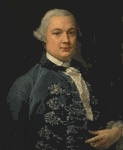KINNAIRD HOUSE
History of Kinnaird House, Larbert, Stirlingshire, Scotland.
If you have any information or pictures that you could contribute to this web site, please send it to:
Contact:
old House & Bruce Family
In 1229 the lands of Kinnaird House were given to the Abbot of Holyrood and were sold to Sir Alexander Bruce of Stenhouse and Airth in 1476. The original mansion of Kinnaird was built in the early 17th Century.
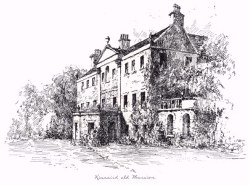
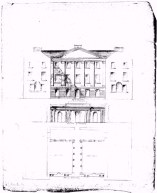
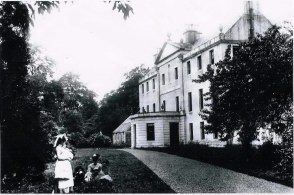
Mr Robert Bruce was the first of a new family of Bruces of Kinnaird. He was born in 1554. He studied Theology against the wishes of his parents who asked him to resign the estate, which he did willingly. he became a great preacher and a favorite with King James VI of Scotland and his father restored him to the estate in 1590. Bruce fell out of favour with the King, having publicly rebuked him from the pulpit and the King banished him overseas. He was allowed to return as a ward of Kinnaird to remain within 3 miles of his estate and had to forefeit his preaching (this was in 1603). In 1629 Charles I was King and he permitted Robert Bruce to preach in Larbert Church (unpaid) where he became very popular and preached to large congregations. He died in 1631 and was buried in Larbert Church, between 4 -5 thousand people attended his funeral.
In 1730 james Bruce of Kinnaird was born, he attended great fame as an explorer and on his journeys in Abyssina he rediscovered the source of the Blue Nile. He was known to his friends as "the Traveller" and died in 1794 as a result of a fall on the steps of Kinnaird House , when handling a lady into her carriage. He was buried in Larbert Church yard and his tombstone is to be seen there today. His son James succeeded him. The Bruce family remained by succession to Kinnaird till it was sold in 1895 to Robert Orr, who demolished the house above and built the present mansion house dated 1897.
The old mansion of Kinnaird does not seem to have been older than the middle of the eighteenth century, although some parts may have been of earlier date perhaps going back as far as the early years of the seventeenth century, when Master Robert Bruce was the laird. The foundations of an old keep were found when the eighteenth century house (Adan's style) was being pulled down. Nothing remains of the old house now. The name Kinnaird in 1334 is said to mean (Gaelic, Cinn na h'airde) "at the head of the height," which refers to its position in days when the sea came much further in. The grounds are very picturesque, It has a very fine approach, where it widens out near the house, with its stately avenue of trees, through which one sees the Ochil Hills. On the wall of the garden there is a coat of arms with the date 1602 over the shield, and the initials R.B. (Robert Bruce), and M.D. (Martha Douglas).buildings.
Who else lived in Kinnaird -1881 census
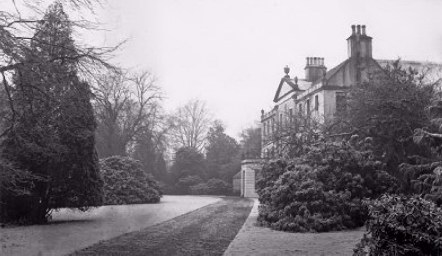
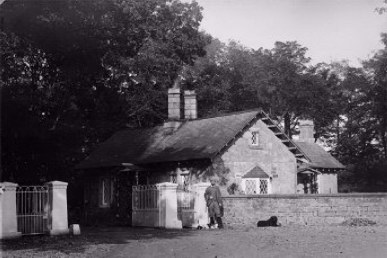
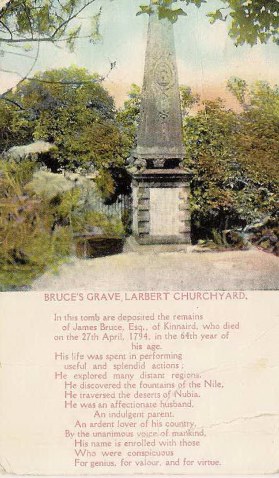
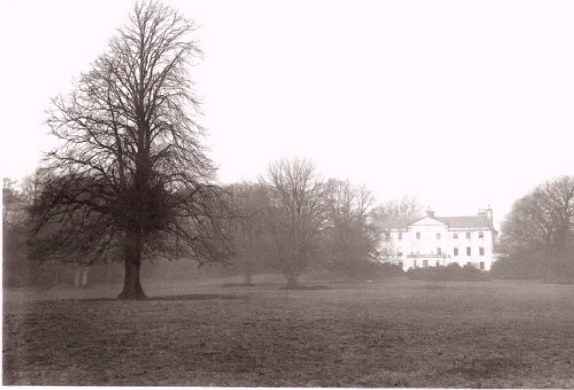
Bruce Family of Kinnaird
Robert Bruce of Kinnaird*, Stirlingshire, is believed to have been born at Airth Castle, c1555, 2nd son of Sir Alexander Bruce of Airth and his wife Janet Livingstone, daughter of Alexander, 5th Lord Livingstone and Lady Agnes Douglas, daughter of John, 2nd Earl of Moray. (*Kinnaird House was situated in Larbert Parish, about 1 mile north east of Stenhousemuir and 3.5 miles from Falkirk.)
He was educated to University level and was intended by his father to follow the law. He completed his education at Edinburgh and began to practise law in the Court of Session, but Robert wanted to study Theology. His parents eventually consented to his going into the church only on his resigning the estate of Kinnaird, which he did, going on to study under Andrew Melville, Professor of Divinities at St. Andrew’s University.
In 1590 he married Margaret or Martha, daughter of George Douglas of Parkhead and Marion Douglas, heiress of James Douglas of Parkhead and Pittendreich. At this point his father restored him to the Barony of Kinnaird.
Nearby Larbert Church having been neglected and left without a minister by the Bishops, was repaired in 1629 by Robert Bruce and here he preached every Sunday to large congregations.
He died 13th August 1631 and was buried in the aisle of the original church at Larbert and it is said that 4 to 5 thousand people followed his body to the grave.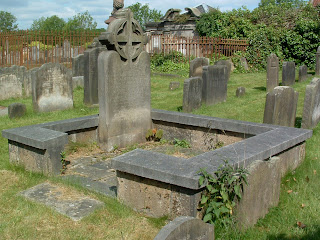

"The mortal remains of Mr. ROBERT BRUCE of Kinnaird
Minister of the Gospel, 2nd son of Sir ALEXANDER BRUCE of Airth
By JANET daughter of the 5th Lord LIVINGSTONE lie intered in this spot
At the foot of the pulpit of the first church in Larbert which he built, and from which he sought
To make known the truth, as it is in Christ
Born 1554 he died 1631 aged 77 years"
Their Children were: Robert, his heir, John, Elizabeth (married James, eldest son of John Campbell of Moy), Mary (married Michael Elphinstone of Quarrell) and Martha.
Robert, 2nd of Kinnaird succeeded his father in 1631. He married Margaret Menteith of the Kerse family. They had two sons, Colonel Robert and Alexander.
Colonel Robert Bruce, 3rd of Kinnaird, Captain of the Life Guards of Charles II succeeded Robert in 1645 but died of wounds whilst a soldier, at the battle of Naseby. He married Dame Marianne Rollo, but the couple had no children. He was succeeded in 1655 by his younger brother Alexander
Alexander Bruce, 4th of Kinnaird married Helen Bruce, daughter of Sir Robert Bruce of Clackmannan and had two daughters - Helen and Jean. After the death of first wife Helen, he married Margaret Elphinstone, daughter of Michael Elphinstone of Quarrell. They had no children.
Helen Bruce, 5th of Kinnaird, eldest daughter of Alexander 4th of Kinnaird succeeded in 1711 'through a deed of entail by which her son and heir and his successors were obliged to retain the name and arms of Bruce'. Helen married David Hay, son of John Hay of Woodcockdale, Linlithgowshire who assumed the name of Bruce.and the couple had one son - David.
After the death of David, she then married Robert Boyd, Writer, Edinburgh
David Bruce, 6th of Kinnaird (son of Helen Bruce, 5th of Kinnaird) succeeded in 1729. He married Marion Graham, daughter of James Graham of Airth, (Dean of the Faculty of Advocates and Judge of the High Court of Admiralty in Scotland) and they had (besides other children), James, his heir. He then married Agnes Glen by whom he had 6 sons and 2 daughters.
James Bruce, 7th of Kinnaird, born at Kinnaird 14th December 1730. Educated at Harrow & Edinburgh University where he studied law. He went to London and in 1754 married Adriana Allan, the daughter of a rich wine merchant and became a partner in the business. Adriana died at Paris within a year of their marriage. James Bruce now went on to study languages and travelled in France, Spain, Portugal & the Netherlands. His father died in 1758 and he returned to London. In 1761 he retired from the wine trade. In 1763 he was appointed Consul General at Algiers. There he studied oriental languages and surgery.
In June 1768, he proceeded to Alexandria and from Cairo set out on his famous journey to Abyssinia. He arrived at Jeddah in April 1769, reached Gondar, the capital of Abyssinia in February 1770 and in November of that year succeeded in reaching the sources of the Abawi, then considered the main stream of the Nile.
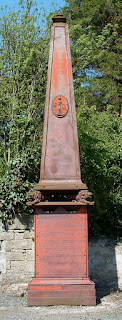
In 1774 he returned to Scotland and on 20th May 1776 married Mary Dundas, eldest daughter of Thomas Dundas of Carron Hall. The couple went on to have 3 children
His "Travels to Discover the Source of the Nile" was first published in 1790.
His death is reported to have been quite tragic. He had been entertaining at Kinnaird and when assisting a lady to her carriage, his foot slipped and fell on the steps. He died in the early hours of the next morning, Sunday 27th April 1794 age 63. He was buried in Larbert Churchyard.
He left 2 sons, Robert who died young and James who succeeded him, also a daughter Janet Maitland who married John Jardine.
James Bruce, 8th of Kinnaird succeeded in 1794 married Eliza, daughter of William Spicer of Wear in the County of Devon and had a daughter Mary Elizabeth who was heiress of Kinnaird.
Mary Elizabeth Bruce, 9th of Kinnaird succeeded to the property in 1810 and was married 20th June 1822 to Charles Lennox Cumming (who assumed the name and arms of Bruce), 3rd son of Sir Alexander Cumming Gordon, Baronet of Altyre & Gordonstown. They had one daughter, Elizabeth Mary who succeeded to Kinnaird. Mrs. Cummings-Bruce was the author of "The Bruces and the Cumyns".
Elizabeth Mary Cummings-Bruce, 10th of Kinnaird was married in 1841 to James, Lord Bruce who succeeded his father as 8th Earl of Elgin. They had one daughter, Elma.
Lady Elma Bruce, 11th of Kinnaird, was married in 1864 to Thomas John, 5th Baron Thurlow, who assumed the name of Cumming-Bruce. Their children:
James Frederick Hovell Thurlow Cumming-Bruce
Mary Elma Hovell Thurlow Cumming-Bruce
Henry Nigel Hovell Thurlow Cumming-Bruce
Charles Edward Hovell Thurlow Cumming-Bruce
Alice Margaret Hovell Thurlow Cumming-Bruce
The estate was exposed for sale by the Free Church of Scotland under the power of sale contained in a bond and disposition in security, and was bought by Robert Orr, merchant, in Glasgow, J.P., for the County of Stirling in 1895.
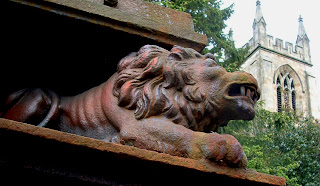
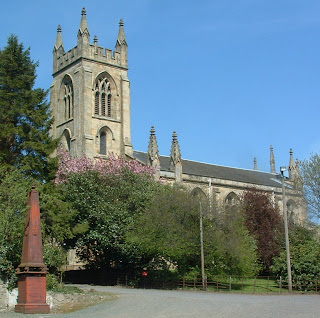
"MARY DUNDAS died the 10th day of February 1780 aged 31 years
JAMES BRUCE of Kinnaird erected this monument as a memorial of his gratitude and affection and her virtues.
At her feet lies the body of ROBERT BRUCE their eldest son died 10th day of November 1778
JAMES BRUCE Esqr. Of Kinnaird died on the 27th of April 1794 in the 64th year of his age.
His life was spent in performing useful and splendid actions
He explored many distant regions
He discovered the fountains of the Nile
He traversed the deserts of Nubia
He was an affectionate husband, an indulgent parent, an ardent lover of his country
By the unanimous voice of mankind his name is enrolled with those who were conspicuous
For genius, for valour and for virtue.
ELIZABETH CUMMING BRUCE
Grand daughter and Heiress of JAMES BRUCE of Kinnaird
Born 1799, married 1820 and died at Kinnaird in 1875
Her husband CHARLES LENNOX CUMMING BRUCE of Dunphial and Roseisle
Born at Altyre February 20th 1790, died at Broomhall January 1st 1875
Representative of the United Counties of Elgin and Nairn and previously of the
Inverness District of Burghs during ten successive parliaments from 1851 to 1869"
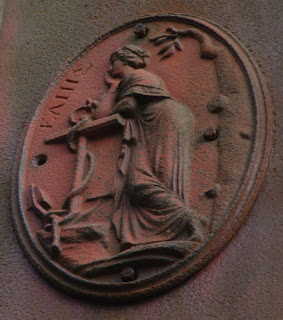
The impressive iron Bruce Monument was cast in Carron Foundry, but now appears to lie quite
forgotten at a 'temporary' spot at the foot of Larbert Churchyard overlooking the River Carron.
It originally sat in a walled enclosure within the Churchyard where it's stone plinth is still located, but due to the enclosure being completely overgrown, this 'Grade A' Listed Monument although now restored, has not been replaced.
(The Monument was given Grade A Listing in 1977.
Plans for the restoration back to it's original location were outlined in 2005)
The Obelisk is believed to have been designed by William Haworth of London who was employed for over 50 years at the Carron Co. as a Designer/Model Maker.
William had trained at the Royal Academy.
Description: Cast-iron obelisk on plinth. Rectangular plinth with rope work edges and long inscriptions to side panels; 4 lions couchant with bared teeth to top corners of plinth supporting obelisk which is capped by classical everlasting lamp.
Oval reliefs depicting goddesses to each side of obelisk.
Amongst the company's major shareholders was John Adam - brother of the famous James Adam who frequently used Carron to cast his fireplaces.
credit to www.memento-mori.co.uk
Posted by Memento-Mori at 08:48
Email ThisBlogThis!Share to TwitterShare to FacebookShare to Pinterest
The James Bruce Monument - Blog by Antonia Dalivalle an independent researcher currently working in the fine and decorative art market in London. credit to https://blog.historicenvironment.scot/2020/11/james-bruce/
In 1785, Bruce commissioned his cast iron monument in memory of his wife, Mary. It would stand in the Bruce family plot at Larbert churchyard overlooking the Stirlingshire landscape that reminded him of Ethiopia.
Manufactured by the Carron Company, it was one of the earliest cast iron obelisks in Britain, and a technical marvel in its day. In 1787, Robert Burns made a point of seeing the ‘fine monument in cast iron’.
After a lifetime of adventure, Bruce was to suffer death by misadventure in 1794. Ever the gallant, rushing to accompany a woman to her carriage, he had a fatal fall down the stairs of his Stirlingshire home.
Two illustrations side by side of the James Bruce Monument, one coloured in and showing more ornate decoration.
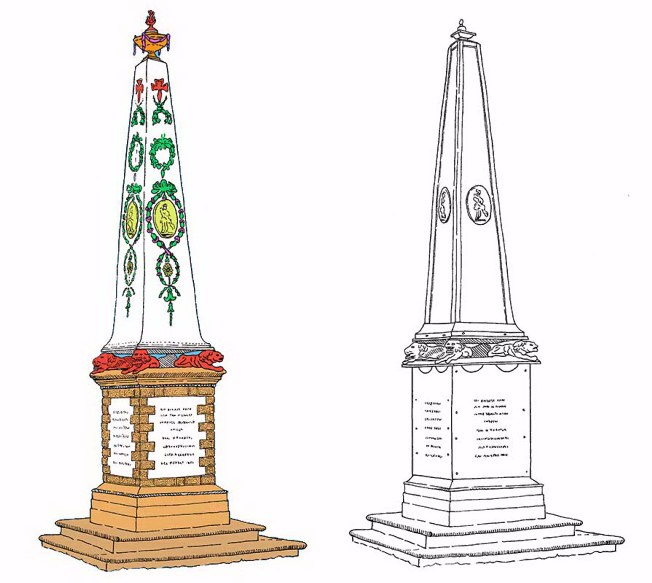
When it was first built, the Bruce Monument was a striking and colourful sight. The images here reveal how the obelisk changed between its erection and 2010. © Geoff Bailey, Falkirk Local History Society
By the beginning of the 20th century, Bruce’s monument was in a lamentable state of decay. In 1902 the Falkirk Herald contrasted the ‘scandalous’ neglect of Bruce’s monument with the enthusiasm shown towards Roman ruins in Scotland. A revival of Scottish nationalism in the early 20th century resulted in the monument’s restoration, which was completed by 1911.
However, after being moved from its original location in 1993, a crane returning the obelisk failed to reach across the wall to its stone mount in the churchyard. The monument was rather unceremoniously deposited at the edge of the car park.
In August 2023 the obelisk was removed for conservation, which was part funded by a grant of £32,500 from Historic Environment Scotland. Once the conservation is complete, the plans are to reinstate it at the Kinnaird family tomb in Larbert Old Parish Church graveyard.
Remembering Bruce
Today, the obelisk is a shadow of its former self. Once brightly painted, its time-worn surface has now rusted into a reddish hue. Its intricate detailed decorative plaques bearing Greek inscriptions have faded over the centuries.

A tall cast iron obelisk by some trees and bushes
The neglect and displacement of Bruce’s memorial obelisk by the end of the 20th century is symptomatic of his story, as a man whose messages were distorted upon arrival in Britain.
Listed at Category A, of historic interest and as a fine example of an 18th century cast iron obelisk, Bruce’s obelisk is a distinctly Scottish ‘stele’.
I personally believe it deserves to be restored to its original state and context. In the current context of re-evaluating British colonial history, it provides important insights into a little-known episode in Scottish-Ethiopian relations.
Antonia Dalivalle is an independent researcher currently working in the fine and decorative art market in London. Antonia’s research into James Bruce uncovers a hidden chapter in the history of British-African relations. She aims to chart the legacies of a relationship between an individual and an independent African country – legacies which appear in unexpected places. What is Ethiopia’s influence on local Scottish history?
Note: this blog was updated in April 2024 to include information on the restoration of the James Bruce Obelisk.
The now restored Obelisk July 2024
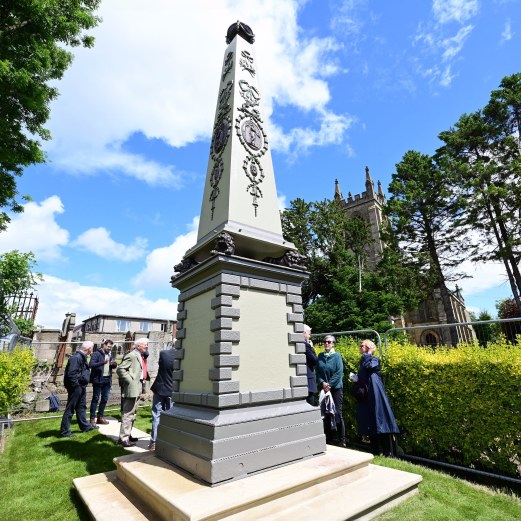
William Symington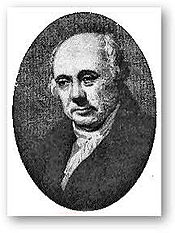

William Symington was born in 1763 in Leadhills, a remote mining village in the Lowther Hills of South Lanarkshire, Scotland. His father worked as a practical mechanic and superintendent at the Leadhills mine and the family was described as “respectable but not wealthy”. Although his parents were keen for him to enter the ministry he preferred to make a career as an engineer. On leaving school he worked as an engineer at Wanlockhead mine in the neighbouring village, where his brother George also worked. In 1784 William had designed a pumping engine at Wanlockhead trying not to infringe Watt’s patent. Gilbert Meason, manager of the mine, recognising William’s talent, sent him to the University of Edinburgh in 1786 to spend a few months attending science lectures. In 1786 William and George built a model steam carriage powered by a version of a Watt engine. William Symington cleverly combined the efficiency of the Watt engine with the simplicity of that devised by Thomas Newcomen and with Gilbert Meason’s encouragement and financial support, was able to demonstrate the practicality of his idea. In 1787 he patented his own improved atmospheric engine. His new engine worked by condensing the steam under a second piston which was then pushed down when fresh steam entered the cylinder, forcing out the condensate. The power piston worked by the atmospheric pressure acting on the vacuum created by the condensing steam. In 1788 William Symington was asked by Patrick Miller of Dalswinton House, near Dumfries to fit a steam engine to his boat to drive the paddlewheels. Symington adapted his steam carriage engine for the boat and proved that steam could power a boat. A second trial took place in December 1789 at Carronshore but Miller withdrew his support and it was 12 years before Symington worked on steam navigation again. William Symington had been working with the Carron Iron Works supervising the construction of the engine for Patrick Miller’s second vessel. By 1790 Symington had moved to Falkirk and become consulting engineer at the Carron Company. Symington had a son with Ann Miller in 1789. In 1791 he married Elizabeth Benson, whose father was a foreman with Carron Company, and they had 6 children, all born in the Falkirk area. Although Symington is best remembered for his contribution to steam powered vessels, he also built engines for mines and mills. The first of these was built on a mine in Wanlockhead in 1790, followed by engines in Sanquhar, Yorkshire and in London.
In 1792, he built a large pumping engine that James Watt was also considered for and built an engine for the colliery of Sir James Bruce of Kinnaird. In 1793, he developed a crank drive with a crosshead above the cylinder, and built such an engine to wind coal from one of Bruce's pits. His engine proved very successful and about fifteen were built. In all, there are firm references to thirty-two engines built by Symington up until 1808, and passing mention of several more. When Sir James Bruce of Kinnaird died in 1794 Symington was offered the post of colliery manager, or viewer, at Kinnaird Colliery. His salary for this was £100 per annum and a house on the estate. While there he worked on 3 steam engines and by the year 1800 15 other engines had been built to his patent, not only in Scotland but also in Yorkshire and London. This appointment ended in 1800 when Symington took over management of the Grange colliery near Bo'ness, belonging to William Cadell. In 1804, following on after the Charlotte Dundas, Symington joined a local businessman in a partnership intended to manage the Callendar colliery at Falkirk but the venture ended badly for him. Symington continued to live in the Falkirk area until 1929 when he moved south to London to live with his daughter and son in law. He died there in March 1831 during a fever epidemic. Fear of the epidemic kept others away from his burial and only four people attended. William Symington’s work on marine engineering was a major influence on the early development of steam propulsion but he was a practical man, an engine builder, not a businessman and he failed to profit from his inventions. His achievements were outstanding and he is recognised far and wide as one of the great Scottish mechanical engineering pioneers.

